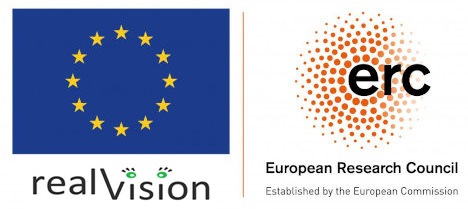Projects
Impact of focus cue presentation on perceived realism of 3-D scene structure: Implications for scene perception and for display technology
Joseph March(1), Anantha Krishnan(2), Rafał K. Mantiuk(1), and Simon J. Watt(2).
(1)University of Cambridge, (2)Bangor University
Published in the Journal of Vision, February 2024 Issue
Abstract
Stereoscopic imagery often aims to evoke three-dimensional (3-D) percepts that are accurate and realistic-looking. The gap between 3-D imagery and real scenes is small, but focus cues typically remain incorrect because images are displayed on a single focal plane. Research has concentrated on the resulting vergence accommodation conflicts. Yet, incorrect focus cues may also affect the appearance of 3-D imagery. We investigated whether incorrect focus cues reduce perceived realism of 3-D structure (depth realism). Experiment 1 used a multiple-focal-planes display to compare depth realism with correct focus cues vs. conventional stereo presentation. The stimuli were random-dot stereograms, which isolated the role of focus cues. Depth realism was consistently lower with incorrect focus cues, providing proof-of-principle evidence that they contribute to perceptual realism. Experiments 2 and 3 examined whether focus cues play a similar role with realistic objects, presented with an almost complete set of visual cues using a high-resolution, high-dynamic-range multiple-focal-planes display. We also examined the efficacy of approximating correct focus cues via gaze-contingent depth-of-field rendering. Improvements in depth realism with correct focus cues were less clear in more realistic scenes, indicating that the role of focus cues in depth realism depends on scene content. Rendering-based approaches, if anything, reduced depth realism, which we attribute to their inability to present higher-order aspects of blur correctly. Our findings suggest future general 3-D display solutions may need to present focus cues correctly to maximise perceptual realism.
Materials
- Paper:
Impact of focus cue presentation on perceived realism of 3-D scene structure: Implications for scene perception and for display technology
[paper PDF] - Supplementary materials [PDF]
Citation
Joseph March, Anantha Kishnan, Rafał K. Mantiuk, and Simon J. Watt
Impact of focus cue presentation on perceived realism of 3-D scene structure: Implications for scene perception and for display technology. Journal of Vision 2024;24(2):13
https://doi.org/10.1167/jov.24.2.13.
Impact of correct and simulated focus cues on perceived realism
Joseph March(1), Anantha Krishnan(2), Simon J. Watt(2), and Marek Wernikowski(1), Hongyun Gao(1), Ali Ozgur Yontem(1), Rafał K. Mantiuk(1).
(1)University of Cambridge, (2)Bangor University
To be presented at SIGGRAPH Asia 2022, Technical Papers

In scenes containing complex objects at different depths we study the impact of focus cues (defocus blur, chromatic aberration, .etc), both near physically correct and simulated, on the perceived realism of content viewed on a multi-focal high-dynamic-range stereoscopic display.
Abstract
The natural accommodation of the human eye to different distances results in focus cues, which contribute to depth perception and appearance. Since focus cues are very difficult to reproduce in an electronic display, it is desirable to know how much they contribute to realistic image appearance. In this work we quantify the potential benefit of focus cues in terms of increased realism compared to regular stereo image presentation. As a secondary goal, we evaluate whether three depth-of-field rendering techniques, which reproduce defocus blur at three different degrees of accuracy, can reintroduce the benefits of focus cues. Our findings confirm the importance of focus cues for realistic image appearance, and also show that they cannot easily be substituted by depth-of-field rendering.
Video
SIGGRAPH Asia'22 talk(12 mins)
Materials
- Paper:
Impact of correct and simulated focus cues on perceived realism
[paper PDF] - Supplementary materials [PDF]
- Scaled per condition data [ZIP]
Citation
Joseph March, Anantha Kishnan, Simon J. Watt, Marek Wernikowski, Hongyun Gao, Ali Ozgur Yontem, and Rafał K. Mantiuk
In SIGGRAPH Asia 2022 Conference Papers (SA '22). Association for Computing Machinery, New York, NY, USA, Article 22, 1-9.
https://doi.org/10.1145/3550469.3555405
Contact
Please contact Joseph March or Rafał K. Mantiuk with any questions regarding the project.
Related projects
Acknowledgements
This project has received funding from the European Union’s Horizon 2020 research and innovation programme under the European Research Council (ERC) Consolidator Grant agreement No 725253 (EyeCode) and under the Marie Skłodowska-Curie grant agreement No 765911 (RealVision).

